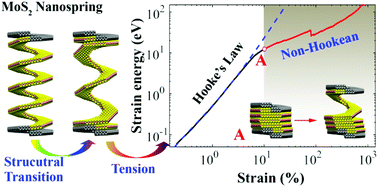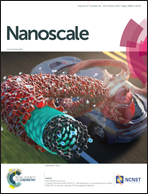Breakdown of Hooke's law at the nanoscale – 2D material-based nanosprings†
Abstract
A helical spring is one of the fundamental mechanical elements commonly used throughout human history, whose deformation characteristic is well described by Hooke's law. Based on in silico studies, this work reported a novel structural transition from a homogeneous morphology to an inhomogeneous configuration in the normal helical nanospring (NS) for the first time, which provides rigorous proof for the “breakdown of Hooke's law” at the nanoscale. Theoretical analyses and numerical results show that the transition is expected to occur in a wide range of two-dimensional (2D) material based normal helical NSs, and the driving mechanism is the interlayer van der Waals (vdW) interactions. A series spring model is established to describe this transition phenomenon by considering the elastic deformation energy and interlayer interactions, which explicitly illustrates the competition between the surface energy and the elastic constant in controlling such a structural transition. It is expected that the structural transition is strictly limited to the nanoscale system, where the interlayer interactions exert significant influence on its mechanical properties. This study provides a comprehensive understanding of the non-Hookean behavior of NSs, and sheds light on their applications in micro- and nanomachines or mechanical systems, such as nanoelectromechanical systems, nanorobots or soft machines.



 Please wait while we load your content...
Please wait while we load your content...